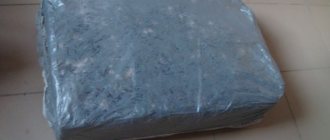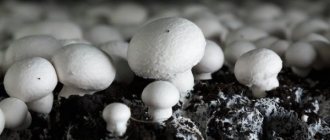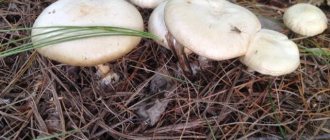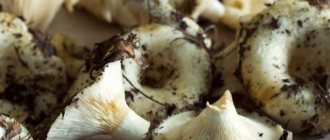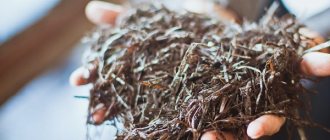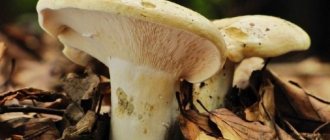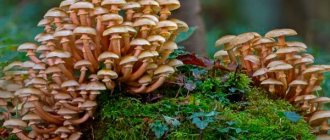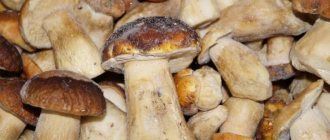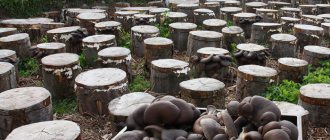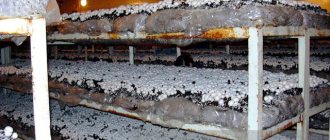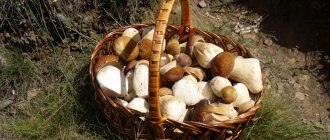Once upon a time, only members of the imperial families of the Middle Kingdom and the Land of the Rising Sun had the right to eat shiitake dishes. Today, it is possible to cultivate it in a regular garden plot; for this you need to know how to grow shiitake at home. Growing an ancient species, the first mention of which is found in documents from 199 BC, is not entirely simple, but not very difficult either. The main thing is to strictly follow all recommendations. And the resulting harvest can be used for food and to get rid of a number of diseases.
Growing shiitake at home
General information about the mushroom
The scientific (Latin) name of this species is Lentinula Edodes. In Europe it is known as Japanese (Chinese) or black forest mushroom. In Korea it is known under the name “pego”; in the Celestial Empire, the original name sounds like “shiang-gu” or “hoang-mo”. The Japanese version - shiitake is translated as “tree mushroom” (“shia” - tree, “take” - mushroom). The name is telling because the plant is a saprophyte - a species that grows on dying trees and stumps. They feed on organic matter, gradually turning it into dust.
Shiitake has been known in China since before our era
Shiitake is found in nature in a wild form. It is especially common in the Japanese foothills, on the slopes of hills in Chinese and Korean provinces, and in Russia it grows only on the hills of the Ural Mountains and in the Siberian taiga. The mushroom is quite capricious in its preferences: it does not like lowlands, severe frosts and excessive heat.
Abundant growth of lentinula is observed after warm spring rains on old stumps and fallen tree trunks. Approximately the same conditions are created for artificial cultivation on an industrial scale - on woody organic matter, in a warm and humid microclimate. Enterprises for breeding shiitake in Russia are organized, for example, in the Moscow, Voronezh and Saratov regions, from where not only ready-to-eat products are supplied, but also seed material for home use.
Shiitake is most widespread in Japan and China when growing wild.
Collection
When it comes to harvesting, farmers' expectations are not always fully met. The culture we are considering can be unpredictable, especially if it lives in artificially created conditions. A slight lack of moisture can reduce yields by half. If the climate is completely suitable for the plant, the average volume of mushrooms collected ranges from 10-22 kilograms of fruit per week from a small plantation.
Every businessman who has connected his activities with the cultivation of shiitake must take into account that with a successful start he will have to be constantly present at the plantations. The harvest period can take several months, and fruits have to be picked almost daily.
Related article - How to store Chinese mushroom: 4 best ways + video advice.
Appearance of shiitake
Shiitake's appearance is not the most outstanding, so it is sometimes confused with other species, for example, with meadow champignons. The mistake is not dangerous, because the second mushroom is also edible, but still not as valuable as lentinula. It is medium in size, distinguished by its expressive aroma and meatiness. The convex cap of the shiitake can have a diameter of 10-20 cm, it is attached to a rather thin stalk. The dome attracts attention with its characteristic “tortoiseshell color” - a dark brown background with flowing beige and cream relief patterns. The edges are edged with a light-colored fringe; the underside of the cap is formed by whitish-yellow plates.
The leg with a fibrous structure quickly darkens when broken; its length can vary from 5 to 18 cm. The surface is painted beige. If darker spots are visible on it, then the mushroom is already too old and does not have useful properties. Lentinula can weigh 80-100 grams.
The mushroom has a cap with a characteristic “tortoiseshell” color.
Shiitake mushroom prices
shiitake mushroom
Harvest
About 10 days pass from the formation of the rudiments of the fungus to its maturation. Shiitake fruits must be harvested before they are fully ripe. This stage is called "technical maturity". You can determine its onset by the caps - they have not yet flattened.
When picking, twist the mushrooms out of the substrate. If you doubt that you will do this carefully, then first cut off the cap with a knife, and why remove the stem. Mushrooms must be placed with the plates facing down and immediately into the container in which they will be transported. In this case, they need to be wrapped in polyethylene.
Next, the mushrooms are sorted. In which, in addition to the usual actions, the lower hard part of the shiitake leg is necessarily cut off.
After the first wave of fruiting, stop spraying for a week. This is necessary so that the mycelium can rest and accumulate nutrients for the second wave of harvest. At the end of this period, immerse the blocks in chlorinated clean water for a day or two. Please note that old and new crops cannot be soaked together. Disinfect water containers first.
When the substrates dry to 60-65% humidity after soaking, a new wave of mushrooms will begin. Keep the temperature at 20-25˚С. The blocks are replaced with new ones after three harvests.
Valuable properties and harm of shiitake
Lentinula edible is a very healthy mushroom, which is confirmed by the latest scientific tests. In total, over 40 thousand works have been written about the properties of this variety, many of which came from the pen of authoritative researchers. For example, in the middle of the 20th century, the effects of the fungus were studied on laboratory mice with sarcoma, which lived for quite a long time after such treatment. As a result of these experiments, it was possible to isolate the substance lentinan from shiitake, which stimulates the synthesis of perforin in the body, which naturally suppresses the growth of cancer cells. Today the drug is available in the form of an immune support product.
Shiitake is widely used in traditional medicine
In Asian countries, shiitake is widely used in traditional medicine and is valued no less than ginseng. It is believed that the mushroom enhances a person’s internal spiritual energy and thereby helps defeat diseases. And modern scientists give an objective assessment of the beneficial qualities of lentinula, but also note the presence of contraindications. Although there are still more of the former.
Cosmetics are made from Japanese mushrooms
Table 1. Benefits and contraindications of shiitake
| Positive traits | Negative qualities |
| 1. Low calorie content - 30-50 kcal per 100 g. 2. An excellent source of protein - an excellent option for a vegetarian diet. In addition, the mushroom contains as much calcium as animal products. 3. The composition contains ascorbic acid, tocopherol (vitamin E), calciferol (vitamin D), thiamine (vitamin B1), riboflavin (vitamin B2), niacin (vitamin B3), pantothenic acid (vitamin B5), pyridoxine (vitamin B6) , folic acid (vitamin B9), iron, zinc, sodium, magnesium, selenium, potassium, glycine, coenzymes and arginines. 4. Regular consumption helps cleanse the blood and improve the general condition of the body. 5. Reduces pressure and prevents the formation of blood clots in blood vessels. 6. When included in the daily diet, the mushroom becomes a means of preventing diabetes, heart attacks, gastrointestinal and thyroid diseases, chronic fatigue, multiple sclerosis, viral infections, and oncology. 7. Included in dietary supplements and specialized medications (for example, immunomodulators and drugs that minimize harm from oncology treatment). 8. Actively used in cosmetology to eliminate acne, enlarged pores on the face, pigmentation, and early wrinkles. An extract from the mushroom is used to create their products by Chanel and Yves Rocher. | 1. When frying in oil, the calorie content of the mushroom increases significantly - it absorbs fats very well. 2. Protein is not very well absorbed by the body, especially weakened ones. For people with gastrointestinal problems, consuming the product risks constipation, bloating and pain in the intestines. 3. Healthy people are also not recommended to consume it in large quantities - a maximum of 300 g per day. 4. The mushroom is contraindicated for allergy sufferers, asthmatics, young children, pregnant and lactating women |
Product sales channels
An edible Japanese mushroom, the taste and aroma is reminiscent of white champignon in density. Its peculiarity is that it is spicy, so the shiitake dish does not require the addition of pepper. This makes it possible to sell it to factories that produce semi-finished mushroom soups, sauces, and seasonings for second courses. In dried form, edible lentinula retains its beneficial properties and aroma, but somewhat loses its taste. The sharpness is maintained if the raw material does not undergo repeated soaking in hot water.
In their raw form, mushrooms are used in almost all dishes of national Japanese, Chinese, and Korean cuisine. The second, highest priority sales channel will be restaurants specializing in the preparation of national dishes of Southeast Asia. Shiitake can be used, after pre-soaking, in European dishes as an alternative to porcini mushrooms.
Japanese mushroom is widely used in pharmacology and folk medicine - this is another opportunity to establish a permanent sales channel. The spectrum of action of beneficial substances contained in shiitake is quite wide - these are:
- reduction in fever;
- fight against viruses;
- treatment of the heart and stomach;
- blood purification;
- increasing immunity and stress resistance;
- normalization of blood circulation;
- reduction in sugar;
- cholesterol breakdown;
- removal of toxins from the body;
- strengthening potency.
As an additional remedy to the main drug treatment, shiitake is recommended for the treatment of the upper respiratory tract, polio, smallpox, influenza, and HIV. In Japan, this micronutrient-rich mushroom is called the elixir of longevity. Fungotherapists recommend this mushroom for:
- cleansing the gastrointestinal tract;
- reducing excess body weight;
- to maintain normal blood sugar levels for diabetics.
Catering outlets specializing in dietary nutrition can also be considered as potential clients.
One of the sales channels can be considered cosmetology concerns that use this mushroom to prepare anti-aging creams, lotions, and masks. The benefits of shiitake in the fight against certain skin diseases have been repeatedly proven by scientists.
Features of cultivating shiitake at home
There are two ways to grow Japanese mushrooms in your garden: outdoors and in a special room. The first method is only suitable for southern regions, since the plant is sensitive to temperature and humidity levels. The second option is absolutely suitable for any area and guarantees high productivity.
To breed shiitake, you need mycelium, which you will have to buy, because it is unlikely to be obtained independently from wild species. It can be ordered at mushroom growing enterprises and in specialized stores. Price: approximately 300 rub. for 250 ml. The date of production must be stamped on the packaging, since seed material is not stored for long.
Shiitake mycelium
Stage No. 1 - Arrangement of the growing area
Not just any room for breeding shiitake is suitable. The best option is a permanent shed with heating or a warm basement with the ability to regulate the temperature. Air must circulate well in a confined space, which means you should take care of the ventilation system. There should also be good lighting that can be dimmed and raised as needed. The lamps will have to be turned on to create the appearance of daylight, at the same time during these hours the temperature is raised to 15-18 degrees, and at night it is reduced to 10 degrees. When the fruiting period begins, the indicator will need to be raised to 24-25 degrees.
The air humidity in the room should be high - 75-85%, so it is more convenient to use drip diffusers for watering. Walls, floors and ceilings are first thoroughly disinfected: washed well with a solution of potassium permanganate. To accommodate myceliums, wide racks in one or several levels are arranged.
The room should be warm and well ventilated
Stage No. 2 - Substrate preparation
To plant mycelium, a nutrient medium is used, which is created by mixing bran, cake, leftover tea leaves, waste left over from beer production, etc. Crushed chalk or thin gypsum is also added to the substrate, which act as thickeners and at the same time neutralize acidity. The formed concentrate must be sterilized to kill pathogenic and foreign microorganisms that can colonize the nutrient medium. To do this, the mixture is placed in metal barrels, diluted with water and boiled for about 4-5 hours. After this, move it to another container and cool.
The finished substrate is packaged in plastic bags with biofilters, which can be purchased at agricultural supply stores. Now you need to carefully mix it with mycelium at the rate of 2-5% of the seed per 5-6-liter bag. The placement of the mycelium should be uniform throughout the entire volume of the nutrient medium. The process is very responsible and requires compliance with sterility rules: you need to put on gloves on your hands, a protective mask on your face, and a clean robe or at least an apron on your clothes.
Substrate in bags
Substrate prices
substrate for plants
Stage No. 3 - Harvesting and harvesting
The first step towards harvest is incubation. This period lasts approximately 20-21 days. At this time, it is necessary to maintain optimally high temperature (up to 25 degrees) and humidity (85%). There is no need to ventilate or light the nursery with mycelium. It is impossible to increase the temperature above the required level, because at 29-30 degrees there is a possibility of activating microorganisms harmful to fungi, such as mold.
As soon as the surface of the substrate acquires a white tint, it means that the mycelium has begun to germinate. You will notice nodules and swellings on it. Now you need to lower the temperature to 17-18 degrees and at night reduce it by another 5-7 degrees. It is also necessary to monitor ventilation and lighting conditions, and maintain the humidity level at 70%. Shiitake should spend at least 5-7 hours in light every day.
The crop is carefully cut with a knife
When the mycelium changes color to brown, the fruiting stage begins and the first harvest can soon be harvested. To quickly form mushroom bodies, the substrate blocks are removed from the bags and placed in cool water for two days, after which they are again packed in polyethylene. After a month, full-fledged mushrooms will have formed, which are carefully cut with a knife. In another 30 days there will be a second wave of harvest, then another. After this, it is recommended to put the mycelium into hibernation for rest, for which the temperature and humidity in the room are lowered. In a couple of months the process can be resumed.
Harvest
Sterilization of substrate and packaging in bags
The substrate is susceptible to mold contamination, which can impair the development of fungi. To prevent this process, the mixture is sterilized:
- Mix the substrate in an enamel container with boiling water and leave for 10 hours, covered with a lid.
- Pour out the remaining liquid after the mixture has cooled and place it in clean bags. To do this, use bags with ventilation, or create holes after forming the block.
- Make a hole in the center of the mixture and populate it with mycelium (up to 150 g of mycelium per 2.5 kg of substrate).
- Insert a gauze or cotton plug into the neck of the bag and only then tie the bags.
This method is suitable for processing large portions of product.
Growing shiitake in open ground
In regions with a warm climate, mushroom gardens can be established directly in the beds. To do this, you need to choose a shaded place, protected from drafts. The mycelium is placed on the trunks of cut trees or unnecessary stumps. It is advisable to choose wood that is not contaminated with mold or other fungi. The diameter of the stumps should be at least 15-25 cm, and the height should be from 100 cm. They are placed not on the ground, but on racks or single supports, many holes are drilled on the surface 2-3 cm in diameter and 10 cm deep. They are placed in these recesses seed and seal the holes with wax or paraffin.
During the incubation stage, it is better to keep the mycelium in a room with a high level of humidity and a temperature of 23-25 degrees. When ripening begins, the plantations are moved outside to a pre-selected location. They are watered with cold water so that the formation of fruits proceeds more intensively. Shiitake will grow on a wooden stump for about 3-5 years, and it is possible to harvest 2-3 crops per season. For the winter, the mycelium is wrapped in polyethylene and sent to a dry and warm barn or basement.
Shiitake outdoors
Substrate preparation
Beginners will be able to achieve active fruiting if they learn the secrets and subtleties of growing shiitake, which begins with preparing a nutrient mixture. For this you can use:
- sawdust from deciduous trees (3 mm);
- shavings from deciduous trees or wood chips to improve air circulation;
- legume flour, grain or tea leaves - to increase nutritional value;
- chalk or gypsum - to improve the structure.
It is best to choose small blocks for sowing - up to 1.5 kg, otherwise it is difficult for the mycelium to spread.
Important! Strictly observe the proportions: 50% sawdust, 25% wood chips or straw, 25% nutrients and 1% chalk.
The total proportion of sawdust and wood chips must be at least 70%. You can use other combinations: 1 to 1 bark and sawdust, 1 to 4 sawdust and rice waste, and 1 to 1 to 1 bark, straw, sawdust.
We grow it ourselves
Shiitake mushrooms on an artificially created stump
Shiitake mushrooms appeared in Russia relatively recently. This is due, among other things, to the lack of large-scale industries. Experienced agronomists have already noticed that growing shiitake mushrooms is not difficult, including at home.
Today there are two ways:
- intensive
- extensive
Each of them has a number of features and, if the necessary parameters are observed, guarantees an excellent mushroom harvest.
